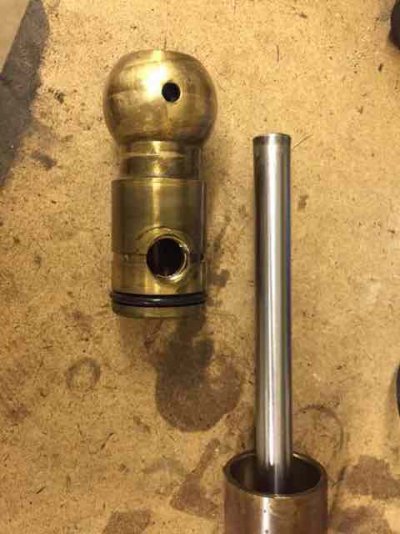Hi Chris, sorry for the lag in response. I know exactly your symptoms, had the same issue with stiff steering at both helms and have been battling with my system for over a year. It has been a maddening, and frustrating, but valuable learning experience. I have completely disassembled both helms, the uniflow and the cylinder multiple times and installed new seals in all. I am not aware of any easy method of testing the check valves "in the univalve" other than disassembly. Note that despite what all the literature says to the contrary, there are also check valves inside the port/starboard line connections to each 250V/275V helm It sounds like your helms are fine however, they are in parallel so only one would / should? be affected by a bad internal check.
If you have noticed any tranny fluid at all, anywhere, your getting air in the system and is likely your entire problem. That little bit on the bottom of the cylinder you noted is all it takes. Air will definitely cause stiff steering as well as lock-ups and screwing up your autopilot. Try running your autopilot manually from hard over to hard over, listen close, if the pump squeals, gurgles or changes pitch at any time, you have air. Before pulling everything apart, as a test you could try fully bleeding the system and see if that improves things temporarily. If not, then I would pull out the cylinder (which you have to do anyway to fix the leak, but also take out the univalve to clean up and instal o-ring kits in both. (comes with instructions). While your at it, you might as well put new seals in your helms. Mine didn't leak at all until I began working on the system, in fact it started to leak virtually everywhere, not sure why.
If the cylinder itself is binding I highly doubt it is internal, having had them apart so many times I just don't see how it could unless it is completely shot. Did you check the rear fixed mount which is ball mounted, when I pulled mine I found it was completely seized from lack of grease. Also check the front clevis mount that the ball moves freely and not binding on the rudder arm. To check, undo one end and swing cylinder back and forth, then do other end. Also have someone turn the wheel hardover both ways while you watch to see if it's binding anywhere.
I put my money on your uniflow acting up. It directs the flow back to the reservoir and if it is stuck/restricted there will be pressure on both sides of the spool in the cylinder causing it to work against itself. This would effect both helms turning in both directions. Chances are it just needs cleaning up and seals. Any defective internal parts can easily be duplicated by a machine shop.
I'm not however put off Capilano, far from it. The newer Capilano 2 line system that does away with the uniflow is in my opinion bar-none the best steering system in the world.
In retrospect if I had half a brain I should have bit the bullet and bought two new 1250/1275 helms and a new cylinder and converted to a two line to do away with the obsolete univalve. Would have been far and away less work but I refuse to be beat, Murphy will not win. It has become a battle between man and machine and I intend to win regardless of pain and cost. Once I've finally won and got the old system working to perfection, I'll rip the damn thing out and go with the new system.




